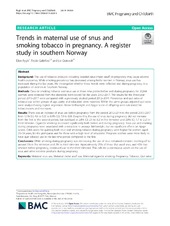| dc.contributor.author | Rygh, Ellen | en_US |
| dc.contributor.author | Gallefoss, Frode | en_US |
| dc.contributor.author | Grøtvedt, Liv | en_US |
| dc.date.accessioned | 2020-04-07T08:49:52Z | |
| dc.date.available | 2020-04-07T08:49:52Z | |
| dc.date.issued | 2019-12-16 | |
| dc.Published | Rygh E, Gallefoss F, Grøtvedt L. Trends in maternal use of snus and smoking tobacco in pregnancy. A register study in southern Norway. BMC Pregnancy and Childbirth. 2019;19:500 | eng |
| dc.identifier.issn | 1471-2393 | |
| dc.identifier.uri | https://hdl.handle.net/1956/21787 | |
| dc.description.abstract | Background: The use of tobacco products including Swedish snus (moist snuff) in pregnancy may cause adverse health outcomes. While smoking prevalence has decreased among fertile women in Norway, snus use has increased during the last years. We investigated whether these trends were reflected also during pregnancy in a population of women in Southern Norway. Methods: Data on smoking tobacco and snus use at three time points before and during pregnancy for 20,844 women were retrieved from the electronic birth record for the years 2012–2017. The results for the three-year period 2015–2017 were compared with a previously studied period 2012–2014. Prevalence and quit rates of tobacco use within groups of age, parity and education were reported. Within the same groups adjusted quit rates were analyzed using logistic regression. Mean birthweight and Apgar score of offspring were calculated for tobacco-users and non-users. Results: There was an increase of snus use before pregnancy from the period 2012–2014 to the period 2015–2017 from 5.1% (CI; 4.6 to 5.5) to 8.4% (CI; 7.8 to 8.9). Despite this, the use of snus during pregnancy did not increase from the first to the second period, but stabilized at 2.8% (CI; 2.5 to 3.2) in first trimester and 2.0% (CI; 1.7 to 2.2) in third trimester. Cigarette smoking decreased significantly both before and during pregnancy. Snus use and smoking during pregnancy were associated with a reduction in average birthweight, but no significant effects on Apgar scores. Odds ratios for quitting both snus and smoking tobacco during pregnancy were higher for women aged 25–34 years, for the primiparas and for those with a high level of education. Pregnant women were more likely to have quit tobacco use in the last time period compared to the first. Conclusions: While smoking during pregnancy was decreasing, the use of snus remained constant, levelling off to around 3% in first trimester and 2% in third trimester. Approximately 25% of those that used snus, and 40% that smoked before pregnancy, continued use to the third trimester. This calls for a continuous watch on the use of snus and other nicotine products during pregnancy. | en_US |
| dc.language.iso | eng | eng |
| dc.publisher | BMC | eng |
| dc.rights | Attribution CC BY | eng |
| dc.rights.uri | http://creativecommons.org/licenses/by/4.0/ | eng |
| dc.subject | Maternal snus use | eng |
| dc.subject | Maternal moist snuff use | eng |
| dc.subject | Maternal cigarette smoking | eng |
| dc.subject | Pregnancy | eng |
| dc.subject | Tobacco | eng |
| dc.subject | Quit rates | eng |
| dc.title | Trends in maternal use of snus and smoking tobacco in pregnancy. A register study in southern Norway | en_US |
| dc.type | Peer reviewed | |
| dc.type | Journal article | |
| dc.date.updated | 2020-01-30T19:39:39Z | |
| dc.description.version | publishedVersion | en_US |
| dc.rights.holder | Copyright 2019 The Author(s) | |
| dc.identifier.doi | https://doi.org/10.1186/s12884-019-2624-9 | |
| dc.identifier.cristin | 1785454 | |
| dc.source.journal | BMC Pregnancy and Childbirth | |

